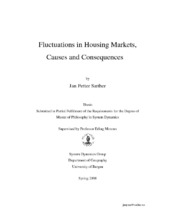| dc.description.abstract | New housing construction represents a relatively small fraction compared to the total mass of housing. Therefore, the supply of housing in the short run is fixed. For this reason relatively small changes in demand for housing will affect prices considerably. If housingprices exceed construction costs, new housing construction will take place. The price-costrelation is important for decision makers in order to start construction of new housing. The number of housing projects in the supply line is not well known and perhaps not taken into consideration by those who decide whether to start new housing projects or not. For this reason, and the fact that it takes considerable time to complete housing projects, there is a potential for fluctuations in the supply of new housing. Consistent with this hypothesis, thehousing market fluctuates considerably more than any other principal activity in theeconomy. Since the supply of new housing fluctuates, employment also fluctuates. Developingefficient worker teams takes time, and recruitment of workers and apprentices occurs when the industry is in expansion. When activity in housing construction is low, recruitment is low, which in turn will imply shortages of skilled labour when the market expands again.Craftsmanship and cost of new housing will also be affected by the quality and efficiency of labour. Fluctuations represent a welfare problem both for the general public and for those whoare working in the construction industry. Fluctuations represent unintentional losses or unexpected profits for house owners who are moving from one home to another asrequirements change. Since fluctuations in the housing market are unforeseeable to thegeneral public, there is also a loss of welfare for those who loose money in transactions in the housing market, for instance when buying a home when market prices are at the top and selling the old home when prices decrease. Much of peoples assets are tied up in residentialproperties – in Norway some 80 percent of the households “own” their homes, more or lessbased on loans. More than in other economic sectors, employees in the building and construction sector are affected by fluctuations. Those who are recruited to the housing construction industry are at a risk of being jobless. On the other hand, when construction activity increases after a depression, the activity increases to unfavourable levels with stress, overtime and rework for those involved. Architects, planners, estate agents and construction workers are all heavilyaffected by fluctuations in the housing market | en_US |
